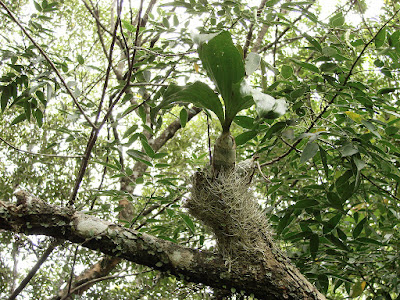Catasetum rodigasianum is endemic to the Brazilian state of Santa Catarina. It grows in the Atlantic coastal forest.
Catasetum rodigasianum also called as Rodigas' Catasetum, Catasetum cernuum var. rodigasianum, Catasetum rohrii, is a species of the genus Catasetum. This species was described by Robert Allen Rolfe in 1890.
IDENTIFY CATASETUM RODIGASIANUM ORCHID PLANT
Catasetum rodigasianum is endemic to the Brazilian state of Santa Catarina. It grows in the Atlantic coastal forest.
It is a medium sized, warm growing epiphyte with fusiform to subconical, curved, 14 cm long and 2 cm wide pseudobulbs carrying 6, elliptic-lanceolate to oblanceolate, plicate, 3 nerved, to 38 cm long and 9 cm wide leaves.
Rodigas' Catasetum blooms in the spring on a pendant, to 50 cm long, 18 to 24 flowered inflorescence holding the flowers towards the apical half. The flowers are 5 cm in diameter with coloration of sepals and petals green with dark red-brown spotting; lip apex yellow-green with the same spotting; column green with a few spots. The female flowers are not seen.
This species has apex of the lip tridentate, similar to that of Catasetum cernuum, but the flowers slightly smaller. Raceme arching and pendent with up to 24 flowers.
CATASETUM RODIGASIANUM ORCHID PLANT CARE AND CULTURE
Cultural information should only be used as a guide, and should be to be adapted to suit you. Your physical location; where you grow your plants, how much time you have to devote to their care, and many other factors, will need to be taken into account. Only then can you decide on the cultural methods that best suit you and your plants.
Light:
Catasetum rodigasianum are sun-loving plant and needs a light level of 30000-60000 lux. Unless the strong air movement found in the natural habitat can be duplicated, however, the grower should provide some shade (40-60 % shade). This species can be grown under lights if sufficient light intensity can be provided, and the plant certainly can be summered outdoors if their moisture requirements can be met.
Temperature:
The climate in their natural habitat is subtropical. The terrain is hilly, with hot, humid air collecting at the base of the hills, then rising and condensing into mist or rain usually late in the day. The forest becomes saturated, with low temperatures at night, but in the morning the sun's rays and drier breezes promote evaporation. The dry season in winter is short, and nighttime humidity is high throughout the year. Temperatures range from a maximum 30°C to a minimum 10°C. In cultivation, 18°C is the ideal minimum night temperature.
Humidity:
Rodigas' Catasetum tolerate an environment with 40 - 60 % relative humidity during their growing season, but for optimal development of new growth and flowering, 70 % is recommended.
Substrate, growing media and repotting:
Catasetum rodigasianum is best to grow in basket cause of its pendent inflorescences with fir bark, osmunda, tree fern fiber, charcoal, and sphagnum, in various proportions or combined with still other ingredients such as sponge rock, perlite, leaf mold, peat, and bark screenings as substrate.
It is recommended to repot every year and never wait more than two years. The optimal time for potting or repotting is when new growth on a plant emerging from dormancy is about 5 cm tall and the nubs have developed into new roots that are reaching for support.
Watering:
In its natural habitat it receives rainfall frequently even while dormant. The plant may be watered every sunny day during the growing season, provided conditions are such that they dry off relatively quickly. This species like to dry out at least slightly between waterings.
Fertilizer:
Fertilize with an appropriate formulation at least every week during the growing season, or fertilize with a weak formula every time the plants are watered. It is important to begin regular applications of high-nitrogen fertilizer (such as 10-5-5) with a full range of trace elements. As the leaves begin to unfurl, and well before flowering, add a high-phosphorus formula to develop big, strong pseudobulbs capable of producing robust inflorescences. Any of the soluble products with a large second-digit number (for example, 3-12-6) constitute a good source of phosphorus.
Rest period:
Catasetum rodigasianum have a relatively short dormant period between leaf fall and new growth. When the plants are leafless and no new growths are visible, the grower must respect their state of dormancy. Watering frequency should be reduced during dormancy. Fertilization should stop completely during this period. In the springtime, at the beginning of the growth cycle, water should not be made regularly available for the newly developing roots until the new growth is at least 5 cm tall.

















COMMENTS